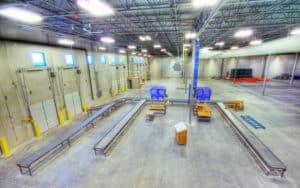INTRODUCTION
The COVID-19 pandemic has changed the world in which we live, and the warehouse industry is no exception. Warehouse operatives are recognized as “key workers,” providing essentials such as food products, pharmaceuticals and household goods. As you face the challenge of keeping up with demand, you may also need to determine how to expand your warehouse.
Here are important considerations as you look to increase warehouse space.
HOW TO DETERMINE USAGE FOR WAREHOUSE EXPANSION
Determining how much space you need to expand your warehouse can help improve the performance of your operations during the pandemic. First, calculate the total storage capacity of the building, keeping in mind the space within the building that cannot be used for product storage.
- Calculate the complete square footage of your warehouse. For example, let’s say it’s 75,000 square feet.
- Subtract the total square footage of space that is used for non-storage purposes (e.g. office space, bathrooms, etc.). In this example, that number is 10,000 square feet, leaving your warehouse with 65,000 square feet of usable space.
- Determine your building’s clear height, which is the distance from the floor to an overhead object. For example, in your warehouse, this could be the distance from the floor to the facility’s steel shell. In this case, the building’s clear height is 25 feet.
- Multiply your total square footage of usable space by your facility’s clear height to determine your warehouse’s storage capacity in cubic feet. (65,000 x 25 = 1,625,000)
Now take the total storage capacity, measure the footprints of all your pallet racks, calculate the total vertical storage capacity and then multiple the true capacity of each of the pallet rackets in your warehouse by the total number of racks you have. Divide this number by the warehouse’s storage capacity in cubic feet (in step 4). This number is the warehouse’s storage cube. If the number is more than 27%, than you likely need to consider expanding. For example. Let’s say your inventory size was 500,000. Then 500,000 / 1,625,000 = 0.30, which means it’s time to expand.
THINGS TO CONSIDER WHEN EXPANDING WAREHOUSE
Assuming you determined that you do indeed need to expand your warehouse, you now need to figure out logistics. Here are a few things to keep in mind:
 What are the zoning restrictions in the space you are looking to expand? Can you build what you want, or do you need to request a variance from the local municipality?
What are the zoning restrictions in the space you are looking to expand? Can you build what you want, or do you need to request a variance from the local municipality?- How will trucks access the site, and what will the vehicle flow look like? Is the ingress and egress for trucks carefully planned to optimize flow?
- Keep in mind your site utilities. Can the existing water, sewer and electric services handle the expansion, or do these services need to be upgraded?
- The building systems may also affect expansion. Does the new overall building size put the area over new thresholds that may require fire alarms or an upgraded fire sprinkler system for the entire facility?

